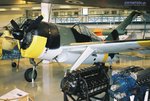kool kitty89
Senior Master Sergeant
I hadn't realized that either the F2A or F4F had belly windows until I played Il-2 Sturmovik (1946 DVD: entire collection up to 1946 addition). The F2A certainly has a more substantial vewing area.
From what I've seen and read all but the XF2A-1 had the window there. A side note: Brewster sold the prototype to the Finns along with the B-239's. Note: aldo, it is incorrect to refer to the Finns B-239's as Buffalos, they were active before the RAF even named the a/c and the Finns simply called the a/c the "Brewster" or "Sky Pearl."
We can't go looking at them now and comparing since there's only one intact surviving:
From Wikipedia:
Another interesting note is that the F2A is the only American built fighter aircraft using a radial engine and with a conical prop spinner to see service in WWII.
From what I've seen and read all but the XF2A-1 had the window there. A side note: Brewster sold the prototype to the Finns along with the B-239's. Note: aldo, it is incorrect to refer to the Finns B-239's as Buffalos, they were active before the RAF even named the a/c and the Finns simply called the a/c the "Brewster" or "Sky Pearl."
We can't go looking at them now and comparing since there's only one intact surviving:
From Wikipedia:
Surviving Brewster Buffalo are extremely rare, as their construction quality was generally poor, and most were quickly dispatched to foreign military service. It was long thought no intact Buffalo remained, but during Summer 1998, a Finnish B-239 (serial no. BW-372) was discovered in a Russian lake, Big Kolejärvi, about 50 kilometers from Segezha, Russia. This aircraft was identified as one of the 44 Model 239s sold to Finland during the Winter War.
On 25 June 1942, BW-372 piloted by Lieutenant Lauri Pekuri was in a formation of eight Brewsters that encountered a mixed squadron of Soviet Hurricanes and MiG-3s. In the clash, seven Soviet aircraft were damaged. Lieutenant Pekuri shot down two Hurricane fighters (he had to his credit 18 kills, including seven Hurricanes) but his fighter was hit by heavy cannon fire from a MiG-3 and he was forced to ditch the burning Brewster in Big Kolejärvi lake. Pekuri survived with minor injuries and managed to walk 20 km to the Finnish lines.
The aircraft was recovered from the lake in 1998, and after extensive negotiations with Russian officials, it was finally transported to the United States. The Brewster fighter finally reached the Naval Aviation Museum in Pensacola, Florida, on 18 August 2004. After discovering the historic nature of the aircraft, original plans to restore and display it as an F2A from the Battle of Midway were quickly dispensed with. The museum plans to reassemble the Brewster and display it exactly as it came from the lake in Russia. Damage caused by enemy fire and subsequent crash landing will not be disturbed. As near as possible, it will be fully authentic and original and instantly recognizable as a Finnish Air Force B-239 at a point in time when it made its last flight in hostile skies and settled to the bottom of the lake.
Another interesting note is that the F2A is the only American built fighter aircraft using a radial engine and with a conical prop spinner to see service in WWII.



